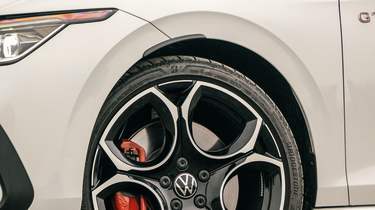Volkswagen Golf GTI (Mk8.5) 2024 review – the update we've been asking for?
The underachieving Mk8 GTI gets a shot at redemption with the new, revised Mk8.5 version. Is it the leap forward it needs to be?
Life hasn’t been easy for the Mk8 Golf GTI. After the heights of the Mk7, which was superbly rounded and one of the best GTIs there’s ever been, things came tumbling down when Volkswagen decided that the Golf needed more digitisation and more screens to move forward into the current decade. We won’t beat what is a very dead horse here, but if you’ve ever tried to tap, poke and stroke your way around the eighth-gen Golf’s interface, you’ll know just how much of a blunder that was.
But it wasn’t just the HMI system. When it launched in 2019, the Mk8 Golf no longer felt like the class benchmark for quality, while as a hot hatch there was a sense that it had lost some of the polish and slickness of its predecessor. Yes it was more powerful and could carry immense speed down a road, but it somehow wasn’t as satisfying to own, live with and drive as the Mk7.
> Volkswagen Golf GTI Clubsport Mk8.5 2024 review – a cut-price Honda Civic Type R?
Perhaps we would’ve looked at the Mk8 GTI more fondly if Hyundai hadn’t come out of nowhere to produce the outstanding i30 N a year earlier. In many ways Hyundai’s first hot hatch felt like a modern reincarnation of the Mk5 Golf GTI, with an addictive, pugnacious attitude and all the sensibilities you need in an everyday car. An archetypal hot hatch, in other words, and so much more exciting (and significantly cheaper) than the Golf. Shame you can’t order a new one anymore.
More reviews
In-depth reviews
- Volkswagen Golf R 2025 review – Mk8.5 not the return to form we'd hoped for
- Used VW Golf GTI (Mk7, 2013 - 2020) review – still the best hot hatch all-rounder
- Volkswagen Golf Mk8.5 2024 review – a return to form for the hatchback benchmark?
- Volkswagen Golf GTI (Mk8) review – the quintessential hot hatchback, but is it the best?
Reviews
Now Volkswagen is having another go at reclaiming the market it has traditionally been at or near the top of by launching an updated Mk8.5 GTI. Or, more accurately, one last go. An electric Mk9 Golf arrives later in the decade, which makes this the final combustion-engined GTI and one with enormous weight on its shoulders. No doubt there will be a number of run-out specials at some point to join this and the more powerful Clubsport, but for the GTI to go out on a high, the base car needs to be good.
It’d be nice to build up to how Volkswagen has gone back to the drawing board and completely reworked the Mk8.5 into the car it should have been all along, but the truth is, not a great deal has changed. Visually, the new car is a bit more square-jawed thanks to a new front bumper; the LED front and rear light units are new, and there are now GTI badges on the front doors, which seems an odd choice. The 19-inch horseshoe alloys are new, too, and have probably ruffled a few feathers at Alfa Romeo.
Climbing into the Mk8.5 feels familiar. Perhaps too familiar. The layout hasn’t actually changed much – the dash is still dominated by a touchscreen and a bank of haptic controls beneath, only this time everything is bigger (the screen measures 12.9 inches) and the touch sliders for the volume and temperature controls are (finally) illuminated. The steering wheel now has physical buttons rather than haptics, too, and Volkswagen has made an effort to improve the speed and functionality of the touchscreen with more processing power and a new UI. It’s definitely quicker to react than before, but accessing some functions is still more complicated than it needs to be.
The driving position is good though, and the flashes of red graphics, carbon-effect trim and tartan cloth are enough to remind you that you aren’t in a 1.5 TSI. Push the starter button and the EA888 engine fires up with a familiar grumble, but you’ll want to fiddle with the GTI’s drive modes before setting off. Tap the shortcut button on the dash and you’re presented with a rather daunting 15-step scale to adjust the (£720) DCC adaptive dampers, as well as settings for the powertrain, engine noise and steering feel.
Ramping up the sound and powertrain to Sport while leaving the dampers and steering in Comfort is a good place to start. With these settings the GTI is painless to drive, with a good level of compliance and light steering efforts to work with. The engine is flexible, pulling well below 3000rpm, and really hard beyond that. You really don’t need to put much effort into driving it quickly, something the GTI has always been good at. It would be nice to have a manual (or at least the option of one – it was discontinued near the end of the Mk8’s life), but the DSG ’box does suit the character of the car and swaps gears smoothly in the background.
What the GTI doesn’t deliver are the ‘wow’ moments you get during your first few miles in a Civic Type R or i30 N. It’s calmer and less communicative than either of those, but if you take manual control of the gears, use more revs and go up three or four notches on the dampers, you might be in for a surprise. The GTI has really, really high limits. The way the front holds a line when charging at an apex is impressive, and you don’t need to be aggressively trailing it in on the brakes for it to bite. We suspect some of this is due to the Bridgestone Potenza S005 tyres; they aren’t an especially aggressive compound but seem to bring out the positivity in the chassis without sacrificing progression. Great in the wet, too.
In Comfort mode the steering is light and a little indistinct, especially around the straight-ahead, and Sport adds extra weight without necessarily improving the sense of connection. Volkswagen says it has fine-tuned the Mk8.5’s steering, but it can feel remote unless you’re really leaning on the tyres, at which point subtle messages begin to come through. As you feed in the power the wheel can lighten in your hands as the diff pulls you through corners, and it shuffles around slightly when putting down maximum torque on a bumpy road.
The diff is an electronically controlled XDS+ unit with a multi-plate clutch. It’s managed by the GTI’s ‘Vehicle Dynamics Manager’ and the locking factor seems less aggressive than in some hatches, including the technically related Skoda Octavia vRS. You don’t feel it fighting to pull the nose tighter under power, and while this means it blends in with the natural cornering process, driving to the strengths of the diff is part of what makes the best front-drive cars so much fun. Perhaps the GTI Clubsport will dial in some extra aggression in this respect.
The calibration of the DCC dampers has been reworked for the Mk8.5, too, and the 15-stage adjustment gives you an enormous range to work with. Fully stiff is far too reactive and almost unusable on the road (it may be helpful on a dry track), but swiping all the way down to the softest setting allows the GTI to eat pretty much anything you throw at it. Bumps roll under the wheels without jostling the body around and you can carry impressive speed, but there’s a laziness in the way it reacts that doesn’t feel very GTI-like. Comfort strikes a good balance between absorption and control, but when the surface allows, somewhere near the middle between Comfort and Sport feels best. The extra support gives the GTI more precision and agility without taking the ride to pieces. You could argue that these settings are another thing to distract you from the job of driving, but once you’ve figured them out, optimising the car for the road and conditions can be quite rewarding.
It feels like everything is powered by an EA888 engine these days. The 2-litre lump first appeared in a GTI for the Mk6, and this latest evo4 unit is the most powerful ever fitted to a base GTI. Now producing 261bhp to the old car’s 242, it punches harder yet retains the slightly flat and one-dimensional character it’s always had. To be fair there’s only so much you can do with four cylinders and a turbo, but Honda, Mercedes-AMG and Hyundai have managed to squeeze more character out of theirs.
There’s nothing offensive about the GTI’s motor, though, and its linear delivery and effortless flexibility suit the package. At no point do you wish for extra urge, and it revs out cleanly to the 6500rpm red line. Pull for the next gear and the shifts are swift, but they can be laggy when going down the ’box – annoying when you’re relying on engine braking to slow into corners. Sometimes this is because there aren’t enough spare revs available to slot into a lower gear, even though it might feel like there are.
Put these pieces together and the GTI is really quite handy for covering ground quickly. Not especially memorable or interactive, but impressive in how it digs in, finds grip and strolls on to the next corner with very little drama. You can brake late into turns and pitch the car in on the nose without it feeling nervous or unstable, the rear taking on a slight angle but never requiring much correction. Once the car is straight, bleed the throttle in earlier than normal to build boost pressure before the engine hits its stride and pulls you away. It’s very effective, and quite satisfying when you get it right. Lightly trimming the brakes into faster corners isn’t quite so easy (the pedal is light and grabby on initial application), but a gentle lift has the same effect of subtly energising the rear and setting you up for the exit.
Then there’s the normal stuff that the Golf does well. When you’re not in the mood you can calm everything down in the drive mode menu, visibility is good and, outstanding ergonomic niggles aside, it’s a pleasant thing to drive day-to-day. Spacious, too, although there is a surprising amount of road noise and resonance that filters into the cabin on poor surfaces. Big imperfections can sometimes upset the ride, too, particularly with the dampers set beyond Comfort. Generally, though, the GTI is a solid all-rounder and it’s one that you warm to as the miles roll by.
Price and rivals
Is this redemption for the GTI, then? The 8.5 is certainly stronger than the 8 in some key areas, but it isn’t a car transformed. Perhaps it doesn’t need to be, given the state of the dwindling petrol hot hatch market. At the GTI’s price point of £38,900 it sits in a different category to our favourite hot hatch, the £50,050 Civic Type R, while the likes of the Mercedes-AMG A35 (£46,000) and BMW M135i (£43,000) are a closer match for the Golf R and GTI Clubsport respectively.
Of what rivals remain, the Focus ST and updated Cupra Leon are probably the GTI’s nearest challengers, but as more makers succumb to emissions regulations and shift funding towards EVs, the competition pool will only shrink. Fitting, then, that the first hot hatch in the traditional sense will also be one of the last ones standing.
Volkswagen Golf GTI (Mk8.5) specs
| Engine | In-line 4-cyl, 1984cc, turbocharged |
| Power | 261bhp @ 6500rpm |
| Torque | 273lb ft @ 1600-4590rpm |
| Weight | 1454kg (180bhp/ton) |
| Tyres | Bridgestone Potenza S005 |
| 0-62mph | 5.9sec |
| Top speed | 155mph |
| Basic price | £38,900 |
This story was first featured in evo issue 326.









